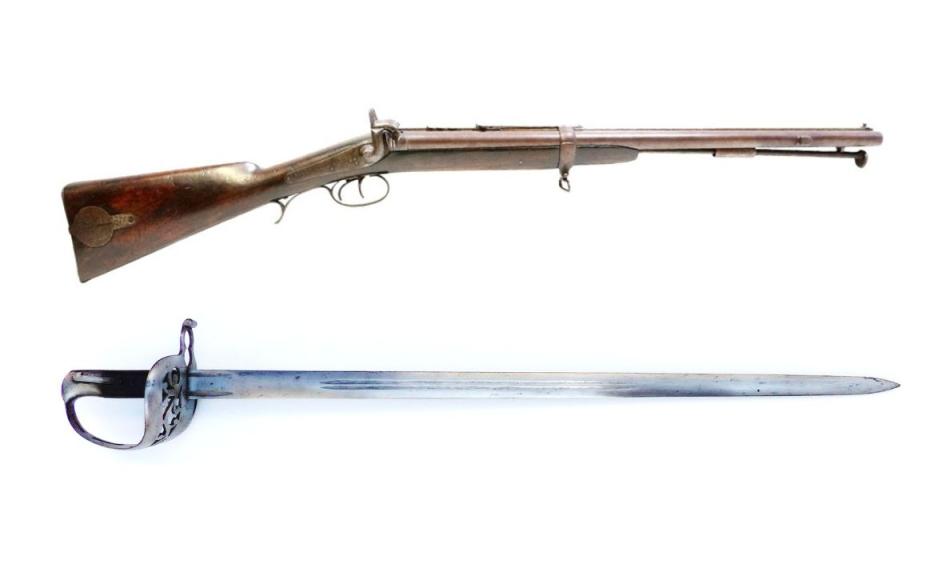Jacob Rifle and Sword Bayonet
This rare double-barrel rifle and bayonet were designed by Brigadier-General John Jacob and produced by Swinburn & Son of Birmingham. Shortly before his death in 1858, Jacob ordered 900 of these rifles, which were issued to his regiment, the Jacob’s Rifles Battalion. They remained in use for a short period after his death before being replaced by the British standard pattern. Some were later used in the American Civil War or sold to American traders, who marketed them as "Elephant rifles."
The rifle measures 40 inches overall, with a 24-inch double barrel of 0.524 calibre percussion and a maximum range of 1,829 metres (2,000 yards). It could fire various types of ammunition, including fulminate of mercury explosive bullets capable of destroying artillery caissons at long range.
The accompanying bayonet is equally distinctive. It features a 76 cm (30 in) double-edged blade with twin fullers and a cut-out basket guard in the Scottish Highland style. The mounting includes a double ring over the barrel and a side clip fixing. Both rifle and bayonet are considered rare items within the collection.
John Jacob was born in Woolavington, Somerset, in 1812, the son of a priest. He was schooled by his father and obtained a cadetship at the age of 14 to the East India Company’s academy at Addiscombe Military Seminary. He graduated in 1828 with a second lieutenancy in the Bombay Artillery and later served during the First Afghan War (1839–42) with the Scinde Irregular Horse, where his considerate manner with the native troops under his command drew the attention of the authorities.
In 1841, he was offered regimental command by Sir James Outram, which he accepted. His first action came in 1842 as a Brevet Captain at the Battle of Meanee with British forces. His regiment played a major role in the conquest of Scinde in 1843 and in engagements against border tribesmen. For his services, he was appointed Companion of the Order of the Bath.
A second regiment of horse, named Jacob’s Horse, was formed in November 1846. In 1847, Jacob was placed in charge of the frontier with his headquarters at Khangurh. The settlement was renamed Jacobabad in 1851 (now in present-day Pakistan) in recognition of his efforts to improve living conditions for the local population. His reputation spread throughout Northern India, and in April 1855 he was gazetted Lieutenant-Colonel and, the following year, appointed Acting Commissioner in Sind.
At the outbreak of the Anglo-Persian War (1856–57), Jacob was given command of the Cavalry and departed for Persia. He was raised to the rank of Brigadier-General and appointed Aide-de-Camp to Queen Victoria. During the 1857 Indian Rebellion, Jacob wished to return to England, but unfinished business in the important commercial port of Bushire kept him in India. He eventually returned to Jacobabad, where he died on 6 December 1858.
Both the 36th Sind Horse and the 36th Jacob’s Horse saw active service in northern and central India, Persia, and Afghanistan, and later in France during the First World War. The two regiments were amalgamated in 1921 and became known as the 14th Prince of Wales’s Own Scinde Horse.
